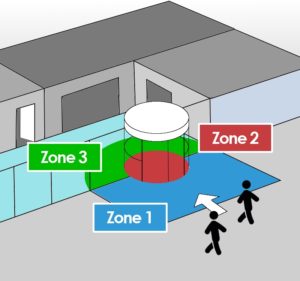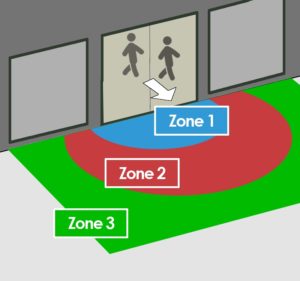Our recommendation to installing Alutrend® mats
The Alutrend® #matting system differ from traditional mats by being much more effective, giving the interior a better look, and last but not least their application is also much more cost efficient. These facts however are strongly dependent on the planning and execution, whereby the specialists of Cleartex Ltd. are at your disposal with 100% customer satisfaction guarantee. With the following specific planning advice we help you at the selection and realization of the optimal mat system.
Planning
One of the critical points while planning a building is the entrance. Only 3-4 collective parts of a giant, e.g. Office building are being used permanently, which means ca. 1% of the building’s flooring. The entrance however is being passed several times by staff and clients every day. Therefore it is not indifferent how high the degree of the building’s permeability is, which kind of wind deflectors and entrance mats are being used and what kind of impression the foreground creates.
The professional planning of an effective and economical entrance matting system takes place at the same time with the planning of the building and the entrance itself, by taking climate and environment into consideration. Of course, a matting can also be planted later, but the late solution carries additional expenses and less harmony. The zone approach as a planning theory thus serve as an effective solution.
- What exactly is the zone approach? The entrances can be divided onto several sections, depending on which types of dirt must be cleaned off. Therefore, it is recommended to use the treads going from the outside to the inside alternating in order to achieve the best possible cleaning and liquid absorbing effect.
- Why should the entrance be designed according to zone approach? The answer is quite simple, because the soles are being cleaned by step-like movements on the mats, while the mat systems automatically clean during the normal passage by simple walking.
- How many sections does an optimal entrance matting have? Basically this depends on the traffic, environment and size of the building, and the types of dirts being carried inside. The ideal clean-running zone consists of three cleaning zones.
- What are the most important aspects when planning the mat system? The most important is the best suiting surface to the number of steps and the surrounding area. For a rotary door, e.g. more steps are being done, than if this length had been passed in a barrier-free area.
- Available treads
- For the outdoor area into the first zone, we recommend the #brush surface with strong scratch effect and #outdoor textiles or the slip-resistant #ribbed rubber with mud wiping effect.
- For the indoor area into the second zone, in addition to these, we recommend #moisture absorbing textile surfaces. In this area it is highly recommended to use mixed surfaces. The third zone, farthest from the entrance, actually has only the task to absorb liquids or to fulfill decorative and marketing tasks with use of #printed textiles.
The zone approach
When it comes to the ideal implementation, the entrance can be divided into three zones. If the building of three zones is not possible, the design of two zones with mixed surfaces is recommended. The basic designing rules are following:
Zone 1.; The primary cleaning zone: #Outside area of the entrance, or directly at the door. The task here is to clean solid dirt and mud. The ideal cleaning surfaces for this area are the brush surfaces, because of their high weather resistance and strong cleaning effect.
Zone 2.; The secondary cleaning zone: #Internal area, closest to the entrance door, #rotary door or #wind deflector. Here the task is to remove smaller solid and wet dirt and absorb moisture. In addition to the mud wiping function of the moisture absorbing textiles also the scratching effect does occur here, that’s why the high liquid suction force and storage capability is very important here.
Zone 3.; The tertiary cleansing zone: #Internal area, the most remote area from the entrance, otherwise also called the #foreground. Here, the main task is to remove dirt from granule size and absorb moisture. In this zone, the fluid intake plays the most important role, also the principle of decoration, which is being offered through numerous textile surfaces and individually printed mats.
Clean running zones
Each entrance is different, as are the shoe scraping habits and weather conditions themselves. The following examples illustrate three completely different cases.
 |
 |
 |
|
General office entrance with rotary door or wind deflector
- Zone 1 | Outdoor area
- Zone 2 | Rotary door,
Wind deflector
- Zone 3 | Indoor area
|
Entrance with intensive pedestrian and wheelchair traffic
- Zone 1 | Outdoor area
- Zone 2 | Indoor area
- Zone 3 | Cannot be built
|
Entrance with intensive traffic without outdoor matting
- Zone 1 | Indoor area
- Zone 2 | Indoor area
- Zone 3 | Indoor area
|
|
Cleaning surfaces
- Zone 1 | Brush, ribbed rubber, scratching fiber
- Zone 2 | Brush, ribbed rubber, scratching fiber, liquid absorbent textile
- Zone 3 | Liquid absorbent or printed textile
|
Cleaning surfaces
- Zone 1 | Ribbed rubber, scratching fiber
- Zone 2 | Liquid absorbent or printed textile
|
Cleaning surfaces
- Zone 1 | Brush, ribbed rubber, scratching fiber
- Zone 2 | Scratching yarns and liquid absorbent textile
- Zone 3 | Printed textile
|
Alutrend® cleaning solutions according to zone approach
The advantage of the Alutrend® entrance mat systems is that they can be adapted individually to entrance and traffic. In particular, the different inlays can be combined with each other, so any kind of individually designed mat system can be put into action.
Zone 1
Outdoor area
|
Zone 2
Outdoor | Rotary door | Indoor
|
Zone 3
Indoor area
|
|
For heavy traffic | Maxi Profile |
- Maxi Rub | Ribbed rubber
- Maxi Brush | Brush
- Maxi Color Brush | Coloured brush
- Maxi Rasp| Scratching yarns
- Maxi Color Rasp| Printed artificial grass
- Maxi Brush & Rub | Ribbed rubber and brush
- Maxi Brush & Rasp| Brush and artificial grass
- Maxi Rub & Rasp | Ribbed rubber and artificial grass
|
- Maxi Brush & Rub | Brush and ribbed rubber
- Maxi Brush & Dry | Brush and liquid absorbent textile
- Maxi Rub & Dry | Ribbed rubber and liquid absorbent textile
|
- Maxi Dry Standard | Needle felt
- Maxi Dry Premium | Liquid absorbent textile
- Maxi Charm | Printed textile
|
|
For moderate traffic | Mini Profile |
- Mini Rub | Ribbed rubber
- Mini Brush| Brush
- Mini Rasp | Scratching yarns
- Mini Color Rasp | Printed artificial grass
- Mini Brush & Rub | Brush and ribbed rubber
- Mini Brush & Rasp | Brush and artificial grass
- Mini Rub & Rasp | Ribbed rubber and artificial grass
|
- Mini Brush & Rub | Brush and ribbed rubber
- Mini Brush & Dry |Brush and liquid absorbent textile
- Mini Rub & Dry | Ribbed rubber and liquid absorbent textile
|
- Mini Dry Standard | Needle felt
- Mini Dry Premium | Liquid absorbent textile
- Mini Charm | Printed textile
|
|
For small traffic | Compact Profile |
- Compact Rasp | Scratching yarns
|
|
- Compact Dry Standard | Needle felt
- Compact Dry Premium | Liquid absorbent textile
- Compact Charm | Printed textile
|
|




